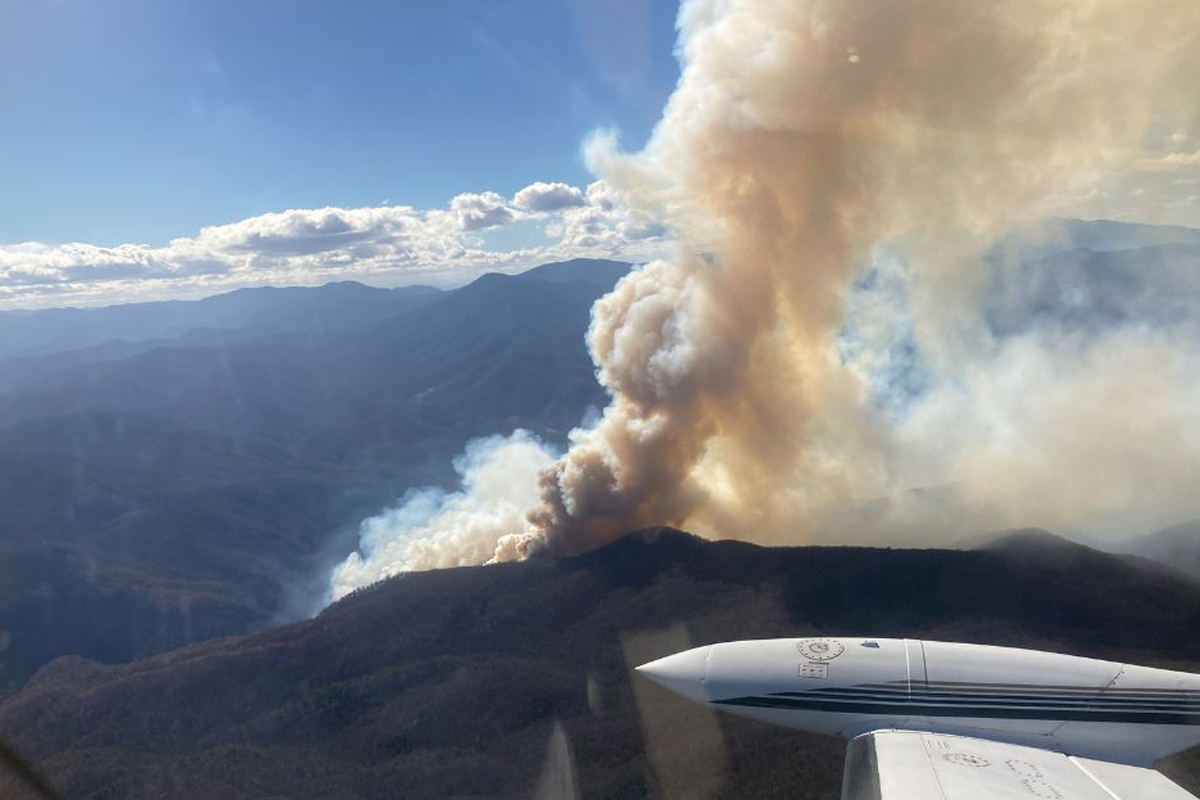Wildfires burn as rain reaches WNC
 The Black Bear Fire burns below an aircraft dispatched to fight the fire. U.S. Forest Service photo
The Black Bear Fire burns below an aircraft dispatched to fight the fire. U.S. Forest Service photo
A steady rain arrived in Western North Carolina Tuesday, Nov. 21, marking the first precipitation of that magnitude the region has seen in two months — but it won’t be enough to end the wildfire season for good.
“The weather we are receiving is helping to moderate or slow fire activity and growth on the current fires,” said Adrianne Rubiaco, fire public affairs specialist for the U.S. Forest Service. “However, it is not a season-ending event. Rather, it’s more of a slowing event. It’s slowing the pace of fire activity and growth.”
Multiple new fires have broken out over the past week even as firefighters work to contain existing blazes that have been burning for weeks. On Thursday, Nov. 16, a tractor-trailer accident on Interstate 40, 3 miles from the Tennessee state line, sparked a fire that grew rapidly, spreading uphill north of the highway. The fire prompted the Forest Service to issue a closure notice that will remain in effect through Dec. 31 or until rescinded.
The closure area includes the A.T. from I-40 to Brown Gap including Groundhog Creek Shelter, the Pisgah National Forest west of Cold Springs Creek Road and Browns Gap Road, south of the A.T. and north of I-40 to the state line, and the Cherokee National Forest north of I-40 to Carmichael Tract Road and south of Carmichael Tract Road, Snowbird Road and Brown Gap Road to the state line. Violation is punishable by a fine of up to $5,000 for an individual or $10,000 for an organization, up to six months in prison or both.
As of press time, the Black Bear Fire covered 1,888 acres and was 42% contained, with 195 people assigned to fight it. Other large fires have also seen significant gains in containment. The Collett Ridge Fire in Cherokee and Clay counties, which started Oct. 23 following a lightning strike, is now 80% contained at 5,505 acres, and the Poplar Drive Fire in Henderson County, determined to be due to a debris fire, is 100% contained at 434 acres.
Even as the promised rain drew closer, land managers continued working to prevent the next large wildfire from starting. In total, there are about 460 people assigned to fires or fire support for the National Forests in North Carolina, including the Collett Ridge and Black Bear fires, and those staged in case a new fire starts.
Related Items
Due to drought and high winds ahead of the expected rain clouds, the Great Smoky Mountains National Park evacuated two of its campgrounds, closed most key roads and urged visitors to leave the park the afternoon of Nov. 20. As of press time, park officials were beginning to assess roads, campgrounds and facilities for any damages sustained from the storm, with an update on the status of park roads expected the evening of Nov. 21.
On Sunday, Nov. 19, firefighters from Blount County, Tennessee, put out a small brush fire at Look Rock in the Great Smoky Mountains National Park, a fire whose cause is still under investigation. The next day, a woman was arrested after members of a construction crew working on Lakeview Drive near Bryson City allegedly saw her set two fires to grass and brush on the road shoulder. The fires were extinguished before they could grow, and the woman was arrested. State and federal charges are pending, the park says.
Hours later, the park was responding to a new fire, this one near Rich Mountain Road just north of Cades Cove. Late at night Nov. 20, the fire was mapped at less than 2 acres but had grown to 6 acres by 2 a.m. Nov. 21, fueled by winds from the south. Blount County coordinated an early-morning voluntary evacuation of homes near the park boundary.
At least an inch of rain is expected in most places in Western North Carolina by the time the system passes through Wednesday morning, and while that’s the most rain many places have seen at one time since mid-September, it’s far from enough to recover from the drought plaguing the region. Currently, nine counties are experiencing extreme drought, a designation not seen in North Carolina since March 2017. An additional 30 counties are in severe drought and 40 counties in moderate drought.
There is no guarantee that this rain will usher in the end of wildfire season.
“That will also depend on what happens over the next few weeks,” said Corey Davis, assistant state climatologist for the N.C. State Climate Office. “If we were to get back into a warm and dry pattern, then this rain could be only temporary relief, and some of the same areas could dry out again and see another spell of late-season fire activity. Fortunately, the outlook for the next 8-14 days is showing cooler temperatures likely for North Carolina with slightly better chances of above-normal precipitation, so that risk of conditions drying out again should be lower.”
Currently, soils are dry 5-7 inches below the surface, so hot spots could continue burning and smoldering even after the rain passes. However, the rain will almost certainly help contain fires that are already burning. Even less than half an inch of rain a couple weeks ago helped push the Collett Ridge Fire from 5% containment to more than 50%,
The winds remain a wildcard. Areas along the Tennessee border could see gusts of more than 30 miles an hour. Especially if rainfall totals in those areas end up being less than expected, these winds could help existing fires spread further.
Burn bans remain in effect for North Carolina’s 30 westernmost counties, 16 counties in eastern Tennessee, the Qualla Boundary, the Pisgah and Nantahala national forests, the Blue Ridge Parkway and the Great Smoky Mountains National Park. Despite the sustained rain Nov. 21, a red flag warning remained in effect for eastern Tennessee and Cherokee and Clay counties in North Carolina throughout the day.









